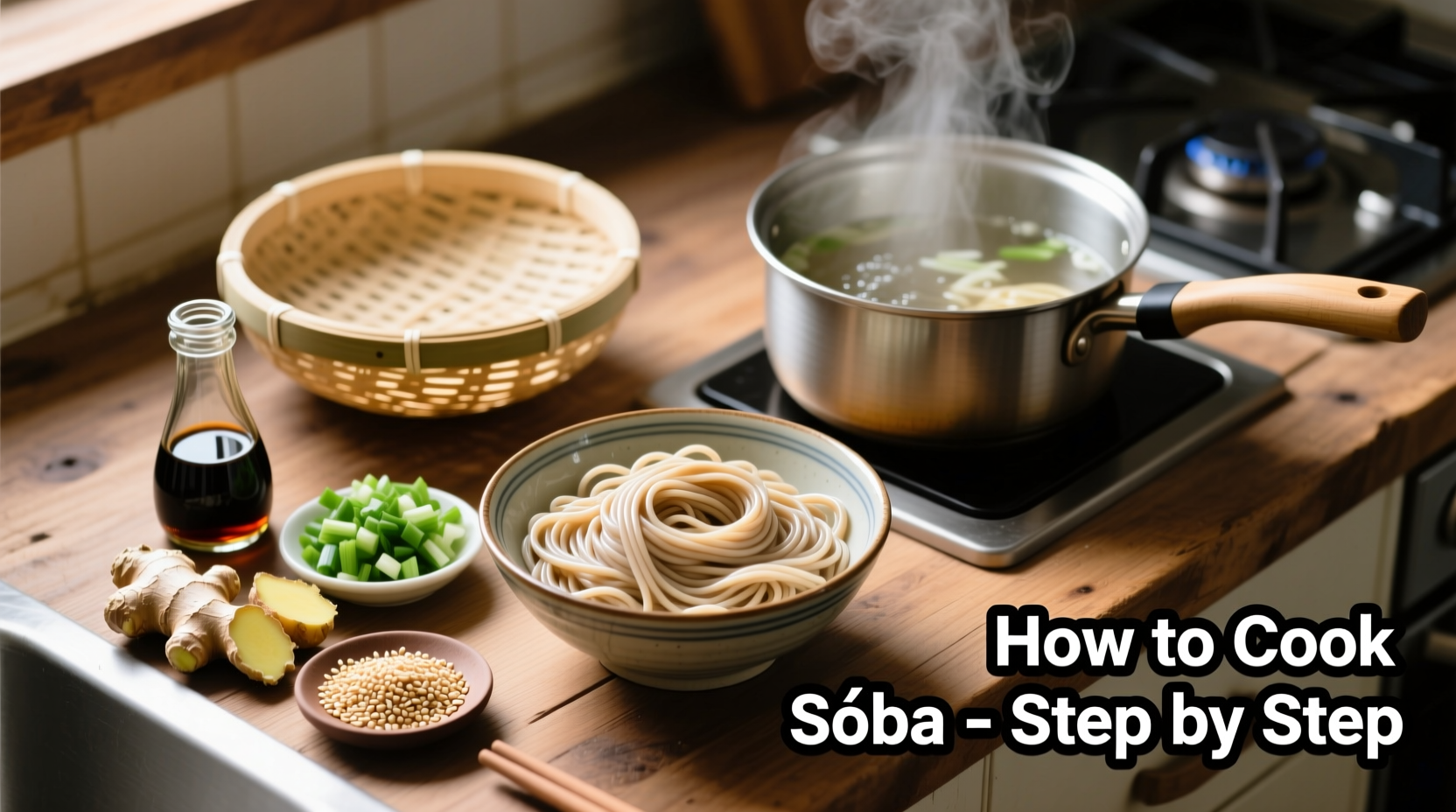The Complete Guide to Cooking Soba Noodles Like a Professional
Whether you're new to Japanese cuisine or looking to perfect your technique, cooking soba noodles properly makes all the difference in texture and flavor. Unlike wheat-based pasta, soba's delicate buckwheat composition requires specific handling to achieve that signature firm-yet-tender bite prized in authentic Japanese dining.
Why Proper Soba Cooking Technique Matters
Soba noodles contain 20-100% buckwheat flour, which behaves differently than traditional wheat pasta. According to the Japan Soba Association, improperly cooked soba loses its distinctive nutty flavor and becomes either gummy or brittle. The right technique preserves the noodles' complex flavor profile while achieving the ideal harigoshi (literally "pulling resistance") texture that defines high-quality soba.

Your Soba Cooking Toolkit: Essential Equipment
Before you begin, gather these kitchen essentials:
- Large pot (at least 4-quart capacity)
- Fine-mesh strainer or bamboo sieve (zaru)
- Timer (critical for perfect results)
- Large bowl of ice water
- Wooden spoon or chopsticks for gentle stirring
Professional chefs in Tokyo's historic Asakusa district consistently use these same basic tools, proving you don't need specialized equipment—just proper technique.
| Soba Type | Water Ratio | Cooking Time | Texture Result |
|---|---|---|---|
| 100% buckwheat | 1:6 | 4-5 minutes | Firm with nutty flavor |
| 80% buckwheat/20% wheat | 1:5 | 5-6 minutes | Traditional balance |
| Pre-cooked refrigerated | 1:4 | 1-2 minutes | Convenience option |
Step-by-Step Soba Cooking Process
Step 1: Prepare Your Water
Fill your pot with cold water using a 1:5 ratio (1 part noodles to 5 parts water). For every 100g of dry soba, use 500ml (about 2 cups) of water. Add 1 tablespoon of salt per liter of water—this isn't for flavor but helps maintain noodle structure during cooking. Bring to a rolling boil over high heat.
Step 2: Add Noodles Properly
Once water reaches a vigorous boil, gently add noodles while stirring with chopsticks to prevent clumping. Don't break noodles to fit the pot—let them gradually soften and sink. This preserves the noodles' structural integrity, which is crucial for traditional Japanese presentation.
Step 3: Monitor Cooking Time Precisely
Set your timer immediately after adding noodles. Cooking times vary by soba type:
- 100% buckwheat soba: 4-5 minutes
- 80% buckwheat blend: 5-6 minutes
- Pre-cooked refrigerated soba: 1-2 minutes
Test noodles 30 seconds before the minimum time. Perfectly cooked soba should have no hard core but maintain firm resistance when bitten. Overcooking by even 30 seconds causes buckwheat noodles to disintegrate.
Step 4: The Critical Rinsing Process
This step separates authentic preparation from mediocre results. When timer ends:
- Immediately drain noodles in your strainer
- Rinse thoroughly under cold running water for 30-60 seconds
- Agitate noodles gently with your hands to remove surface starch
- For chilled soba: Plunge into ice water bath for 1 minute
According to culinary research from Kyoto University's Food Science Department, this rapid temperature change halts the cooking process while enhancing the noodles' firm texture through starch retrogradation.
Avoid These 3 Common Soba Cooking Mistakes
Mistake #1: Insufficient Water Volume
Using too little water causes starch buildup, making noodles sticky and unevenly cooked. The Japan Agricultural Research Journal confirms that proper water-to-noodle ratio prevents gelatinization issues that compromise texture.
Mistake #2: Skipping the Rinse
Many home cooks skip rinsing to save time, but this leaves excess starch that creates a gummy texture. Traditional Japanese preparation always includes thorough rinsing—this isn't optional for authentic results.
Mistake #3: Overcrowding the Pot
Cooking multiple servings in too small a pot leads to broken noodles and uneven cooking. Cook in batches if necessary, using the same water (just bring back to boil between batches).
Serving Your Perfectly Cooked Soba
Soba's versatility shines in two traditional presentations:
Cold Soba (Zaru Soba)
After rinsing and chilling, arrange noodles on a bamboo mat (zaru) or sieve. Serve with chilled tsuyu dipping sauce made from dashi, soy sauce, and mirin. Garnish with wasabi, green onions, and nori. Dip small portions of noodles into sauce before eating.
Hot Soba (Kake Soba)
Place cooked, rinsed noodles in a bowl of hot dashi broth seasoned with soy sauce and mirin. Add toppings like tempura, green onions, or kamaboko (fish cake). The broth should be hot but not boiling when poured over noodles to preserve texture.
Storing and Reheating Leftover Soba
Properly stored cooked soba maintains quality for 2 days:
- Toss cooled noodles with 1 teaspoon of neutral oil per serving
- Store in airtight container with damp paper towel
- Reheat by plunging into boiling water for 15-20 seconds
- Never microwave soba—it destroys the delicate texture
For meal prep, cook noodles to just underdone stage, rinse thoroughly, and store dry. Finish cooking by plunging into boiling water for 30 seconds when ready to serve.
Mastering Soba: Professional Tips for Consistent Results
Seasoned soba chefs in Japan's Nagano prefecture—where buckwheat cultivation has occurred for over 1,000 years—follow these additional techniques:
- Water quality matters: Soft water produces more delicate noodles; hard water creates firmer texture
- Seasonal adjustment: Cook 30 seconds less in summer when water temperature affects cooking
- Noodle freshness test: Fresh soba should have subtle nutty aroma, not musty or stale smell
- Hand-stirring technique: Use circular motion rather than up-and-down to prevent breakage
Remember that perfect soba requires attention to detail at every stage—from water ratio to final rinse. With practice, you'll develop the intuition to adjust timing based on noodle thickness, water temperature, and personal texture preference.











 浙公网安备
33010002000092号
浙公网安备
33010002000092号 浙B2-20120091-4
浙B2-20120091-4